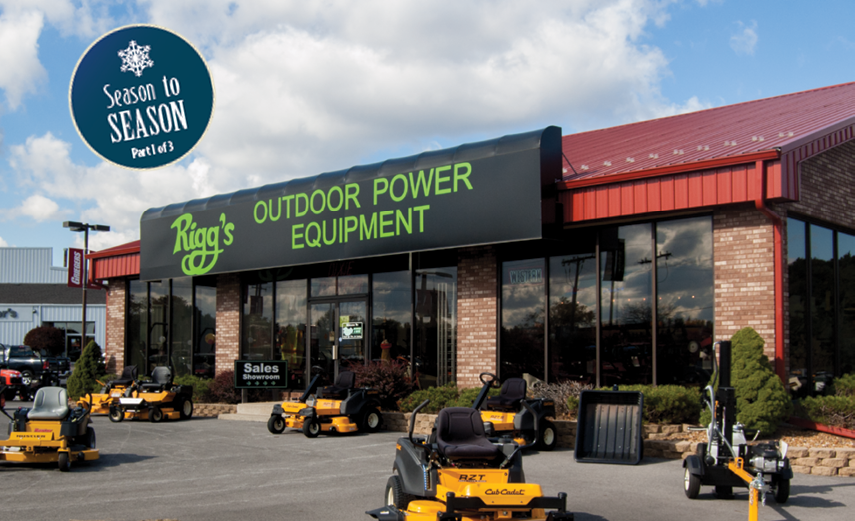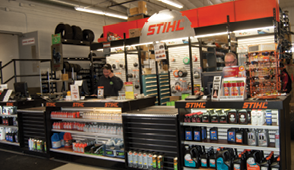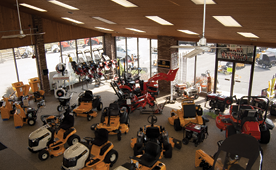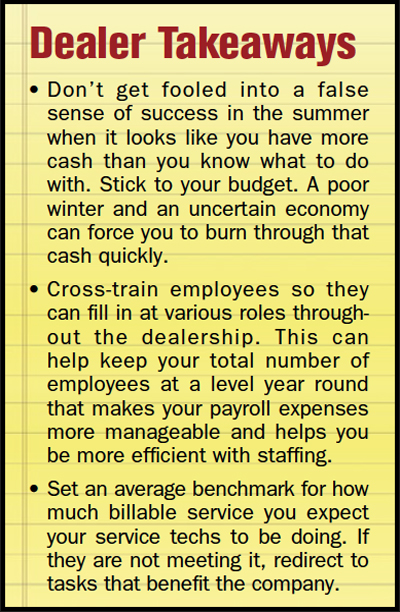
There’s no question that the outdoor power equipment industry is a seasonal one. However, you always have to be ready for the next thing, says Tom Rigg, founder and co-owner of Rigg’s Outdoor Power Equipment.
“You have to be ready for the next season and you have to keep something going year round; you can’t take the winter off. You need to know how to make equipment work year round. It’ll do more for you than just a one-season job,” he says.
The biggest seasonal challenge can come in the winter. During the worst winters — in this case meaning no snow — Rigg says the service department is doing 30 hours of service work a week instead of 40 or 50. “We had a lot of corners cleaned and a lot of painting got done,” he says. “But, you can’t just clean and fix things because that means you’re spending money. You have to keep some revenue coming, so what we did was chase customers basically. You just have to get on the phones and just chase the customers.”
Managing cashflow and finding the right mix of employees to run efficiently during the slower seasons is a common challenge among rural lifestyle dealers. The steep drop off in cashflow during the winter months is one of the biggest seasonal challenges the Indiana-based dealership faces.
Outdoor Power Equipment Valparaiso, Ind.
Founded: 1981, with stores in Valparaiso, Mishawaka, La Porte and Lafayette, Ind.
Location: The Valparaiso store is located a few miles off of I-65 on Highway 30 at the intersection of rural and suburban markets. Each location serves a variety of customer types including, residential, municipal, agricultural and commercial.
Lines: Kubota, Hustler Turf, Cub Cadet, Stihl, Dixie Chopper, Western, Land Pride, Toro Consumer, Honda Power Equipment and Western Snow Equipment
Challenge & Solution: Rigg’s Outdoor Power Equipment works to find the right balance of employees to manage through the slower winter months, but still maximize the high volume of business in spring and summer. Managing cashflow is a year-round challenge.
Rigg’s Outdoor Power Equipment has 4 locations in northwestern Indiana. Its headquarters is in Valparaiso.
Winning the Cashflow Battle
Managing the company’s finances is a full-time job for office manager Sherry Pullins, but cashflow can become particularly challenging during the winter months. All the paperwork from all 4 locations flows through Pullins’ desk. She handles accounts payable and receivable, registrations, insurance, payroll, inventory audits for finance companies and retail financing.
“You go from a cash glutton in-season where keeping up with bills is easy to really having to be smart about the way you manage cash in the winter. The season makes a big difference in how we approach managing our cash,” Pullins says about the financial challenge of the off season.
“You have to be ready for the next season and you have to keep something going year round; you can’t take the winter off…”
As Rigg’s was preparing for this winter, the dealership was hit with what co-owner Geoff Blanco refers to as the perfect storm of cash management challenges. In the course of 2 or 3 days, all of the vendor floorplan companies showed up to do floor check audits. “We had to reconcile for all of the sold inventory for multiple vendors at the same time. So, you pay out all of that and you have to take care of your regular monthly statements that are due as well. That is a big challenge,” Pullins says.
Outside Experience Adds Different Perspective
Geoff Blanco spent 15 years in the IT consulting industry as a sales and marketing executive prior to becoming an owner at Rigg’s. “One may ask how the experience from being a vice president of sales and marketing working with Fortune 500 companies translates into the outdoor power equipment industry,” says Blanco “The answer is that it doesn’t in some areas of the business. For instance, I couldn’t tell you the difference between a clutch and a flywheel,” he says. “But the value that experience does provide is in growing the business and seeing it reach its potential. Business planning, sound financial practices and organizational development are critical to growing a small business into a mid-sized business.”
Blanco adds, “I was a customer here at Rigg’s before becoming an owner and experienced first-hand the fantastic people that work here and the potential they represented. I take great pride in working with these people, our accomplishments and the future that is out there for us.”
In addition to the surprise inventory visits, third quarter taxes were due. “Property taxes,income taxes, sales taxes, regular monthly bills and then all those vendors at one time put a strain on cashflow in a hurry,” Pullins says. “Meanwhile, standard operational expenses continue to roll in as well as some that are budgeted and some that are not. However, at the end of the year, it has to balance to a profit that keeps the business on track for growth. ”

Nick Stergos is vice president of parts and service of Rigg’s Outdoor Power Equipment.
Pullins tries to balance the due dates as best she can, but that’s not always possible. “It’s a balancing act when it comes to paying. You try to space them out as best you can. When we get a little tight, I try and space out some of the large orders from week to week just to see what comes in, what goes out,” she says.
Pullins has yet to discover the perfect solution to managing the cash flow with so many variables and timing that she cannot always control. She says she is working with the store managers to space out big orders so that payments aren’t coming due around the same time in the winter. She believes part of the solution is good communication and planning.
When the season slows and Pullins gets a break in the action, she and Nick Stergos, vice president of parts and service, work together to tackle another dealership challenge: managing employee hours and payroll.
Balancing Employee Work Time
With labor costs being among Rigg’s biggest expenses, managing employee hours during the slower times is also a challenge. “We haven’t always done a very good job, but we’re much better than we used to be,” Blanco says. “Employee hours would go up quickly with the spring season and then trail off a lot slower than they should when the amount of work coming in slows with the winter season. The question then becomes what are we doing with our time if it’s not directly attributed to a customer interaction? We found we did not always have a good answer to that question.”

When winter begins to wind down, the parts and service department employees will start calling customers to create pre-season service for the spring.
To help manage cashflow, Pullins and Stergos work to balance the number of hours employees work with the amount of work coming in. “For technicians, we are looking much more closely at billed hours vs. clock hours and have a minimum ratio of 85% for mechanics. We are also using tactics like rotational days off for hourly employees to match staffing resources to customer demand,” Stergos says.
As a benchmark, Stergos figures a good service tech should generate $12,000 of the dealership’s typical service business a month on

Rigg’s Outdoor Power Equipment’s Valparaiso location was previously a car dealership. With floor to ceiling windows on three walls, the showroom extends to the lot outside.
average. “A good tech will do more than that and a tech that’s not as productive will do
less, so we use $12,000 as an average,” he explains. “If the service department is only doing $12,000 in service revenue a month, and you have 2 techs in that store, we have a problem in that we’re not generating enough revenue to cover our operating costs and can’t contribute to the dealership’s growth expectations.” And that’s where the seasonality of the business is tough.
“On top of that, if you let a technician go when times are slow, when business picks back up, you’re down a tech when you need them most. With the techs, we may have to carry them through the slow months so that when we hit the in-season peak we’ve got the resources to get it done. Even in winter we are very critical of that 85% minimum billable requirement for them,” he says.
Another way to manage payroll expenses is to make employees as multi-functional as possible, Blanco says. “The challenge is finding the right balance of employees to power through the busy times yet be lean enough in the winter to reach acceptable net profit levels and still provide excellent customer service. I think the days of being stove-piped where a mechanic is only a mechanic, a parts guy is only a parts guy and a sales guy is only a sales guy no longer works as margins get slimmer and competition increases,” Blanco says. “We have to be able to apply resources to the part of the business where the demand is at the time. You have to have a salesperson who can sell at the parts counter if that is where the customers are at that time. You have to have a driver that can do setup, a mechanic who can come to the service counter if necessary to cover for a few hours, and a store manager that can do it all. That lets you balance your workforce to meet not only seasonal demands but daily retail demands as well.
“What we don’t want to do is pay out all our profits acquired in-season to cover payroll during the winter months. By having talented employees capable of functioning in multiple parts of the business, we are able to keep a smaller number of people busy most of the time vs. too many people busy just some of the time. Then you can use that profit to reinvest in other ways in the business.”
Blanco adds, “With that said, our staff all have their primary jobs and spend the majority of their time doing those jobs. When the need is there, we can shift people which maximizes our resources in the slow months.”
Leveraging Seasonal Employees

Rigg’s has found a way to incorporate seasonal employees to help balance the workload throughout the year. These seasonal employees include office help, set-up and equipment drivers. For example, in early March, Rigg’s hires drivers and starts training them so they are ready when things really pick up in the spring and summer. By the middle of September, Stergos says, they are to the point where things start to slow up and they no longer need drivers for 40 hours a week. “By the beginning of October, we really don’t need a driver in some stores so we use the available bandwidth of the other employees to do that function. This also lets us make sure our core employees get in the hours they need for their own paychecks so we can retain them long-term. We have a lot invested in these people and want to make sure we keep them but also be a good company to work for,” he explains.
Right now, Stergos says the ideal situation is to hire retired people with experience for seasonal drivers. In the fall, the drivers are down to working 2 or 3 days a week, but understand that by the winter months they may not be coming in at all. “But often they are here next spring when we will need them full time again.”
The dealership may also use a junior tech to cover some of the driver responsibilities when things begin to slow. “He might work 3 days in the shop and then fill in the other couple of days driving. So, we don’t have two guys filling one spot on the payroll.”

Sherry Pullins is the office manager for Rigg's Outdoor Power Equipment's
Valparaiso store.
While the argument could be made to hire seasonal techs, that concept hasn’t worked out for Rigg’s. “Techs are difficult to find, so when we find a good one, we’ll find a way to keep him and this is where the cross training is important so he can add value to other parts of the organization. For example, when the shop is slow and the regular parts counter person is on their rotational day off, he can fill in at the counter that day. The ‘win-win’ is that the company reduces its overall head count costs, gives a well-deserved day off and still provides good customer service.”
“Our guys are younger, they’ve got families or want to have families and need to work
regularly, so when we have a good tech we hold onto him. Thankfully, we’ve been busy enough that we’ve never had to cut back on the number of techs and have found creative ways to keep them earning money for the company and themselves when the shops get slow,” Stergos says.
Learning About the Customer by Being the Customer
Tom Rigg, co-owner of Rigg’s Outdoor Power Equipment, has an inside scoop on the seasonal needs of his customers. A few years into opening the dealership, a customer came in and was looking for someone to do landscape work. So, Rigg put his 14-year-old son to work. “Within a few years it turned into a very huge operation,” he says.
Rigg ran the landscape business out of a separate location and was doing about $1 million in snowplowing and landscaping. “I’d always been in the snowplowing business, even before I got in the equipment business. We did both for a long time until it just made me nuts,” he says.
Rigg sold off the landscape business in the late 1990s, but the lessons he learned from running the business continue to influence how he runs Rigg’s Outdoor Power Equipment.
“It taught me what the landscaper needs and what his problems are and what he has to deal with on a daily basis. It helped me understand his equipment needs better, what works and what doesn’t work, things like that. I know what he is dealing with on a daily basis. I understand it really well,” Rigg says.
“You have to be ready for the next season and you have to keep something going year round; you can’t take the winter off. And you have to actually make equipment work year round. It’ll do more for you than just a one-season job, things like that.”
Rigg says tractors are a good example of equipment that landscapers can make work year round. “When I first bought a Kubota tractor years ago for the landscaping business, I justified it by doing ‘bush hog’ work in the summer. I also justified it with a cab and a snowplow for the winter,” Rigg says.
Preparing for Spring
When winter draws to an end, Rigg’s is starting to build Kubota tractors, construction and lawn and garden equipment in preparation for the spring. “Equipment is rolling in here by the truckload by the end of February and we’re setting it all up. It’s no fun because you can’t get outside. It’s just not a great time of the year, but at least we’re keeping busy. Also, if there’s not snow on the ground, the parts and service guys are on the phone trying to get service work in,” Rigg says.
The weather will play a huge role in how successful the dealership is in getting early spring service work. “If there’s no snow and the sun is shining, even if it’s cold out, you can get the customer in to do service. If it’s ugly and wintery looking, you won’t,” he says. 
View Video Interviews with Rigg’s Outdoor Power Equipment
.• Nick Stergos, Rigg’s Outdoor Power Equipment’s vice president of parts and service, discusses setting expectations in the service department and how he projects parts and service revenue for the next year.
• Sherry Pullins, Rigg’s Outdoor Power Equipment’s office manager, shares how she managed the large increase in paperwork and cashflow that came with growing from a 1-store dealership to a 4-store dealership.








Post a comment
Report Abusive Comment